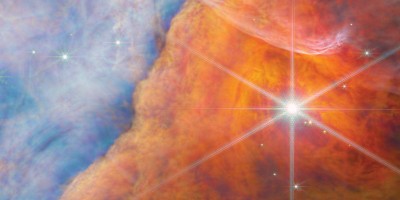
Data availability
All the data discussed here were presented by ref. 1.
Code availability
Our results use the PyNeb code, publicly available on GitHub: https://github.com/Morisset/PyNeb_devel.
References
Chen, Y. et al. Accurate oxygen abundance of interstellar gas in Mrk 71 from optical and infrared spectra. Nat. Astron. 7, 771–778 (2023).
Peimbert, M. Temperature determinations of H ii regions. Astrophys. J. 150, 825–834 (1967).
Cardelli, J. A., Clayton, G. C. & Mathis, J. S. The relationship between infrared, optical, and ultraviolet extinction. Astrophys. J. 345, 245 (1989).
Sutter, J. & Fadda, D. [C ii] map of the molecular ring and arms of the spiral galaxy NGC 7331. Astrophys. J. 926, 82 (2022).
Fadda, D., Jacobson, J. D. & Appleton, P. N. Transient effects in Herschel/PACS spectroscopy. Astron. Astrophys. 594, A90 (2016).
Luridiana, V., Morisset, C. & Shaw, R. A. PyNeb: a new tool for analyzing emission lines. I. Code description and validation of results. Astron. Astrophys. 573, A42 (2015).
Gonzalez-Delgado, R. M. et al. Violent star formation in NGC 2363. Astrophys. J. 437, 239 (1994).
Esteban, C., Peimbert, M., Torres-Peimbert, S. & Rodríguez, M. Optical recombination lines of heavy elements in giant extragalactic H ii regions. Astrophys. J. 581, 241–257 (2002).
Esteban, C. et al. Keck HIRES spectroscopy of extragalactic H ii regions: C and O abundances from recombination lines. Astrophys. J. 700, 654–678 (2009).
Mingozzi, M. et al. CLASSY IV. Exploring UV diagnostics of the interstellar medium in local high-z analogs at the dawn of the JWST era. Astrophys. J. 939, 110 (2022).
García-Rojas, J. & Esteban, C. On the abundance discrepancy problem in H ii regions. Astrophys. J. 670, 457–470 (2007).
Peimbert, A., Peña-Guerrero, M. A. & Peimbert, M. A classification of H ii regions based on oxygen and helium lines: the cases of TOL 2146-391 and TOL 0357-3915. Astrophys. J. 753, 39 (2012).
Rubin, R. H. The effect of density variations on elemental abundance ratios in gaseous nebulae. Astrophys. J. Suppl. Ser. 69, 897 (1989).
Méndez-Delgado, J. E., Esteban, C., García-Rojas, J., Kreckel, K. & Peimbert, M. Temperature inhomogeneities cause the abundance discrepancy in H ii regions. Nature 618, 249–251 (2023).
Méndez-Delgado, J. E. et al. Density biases and temperature relations for DESIRED H ii regions. Mon. Not. R. Astron. Soc. 523, 2952–2973 (2023).
Acknowledgements
J.E.M.-D. and K.K. gratefully acknowledge funding from the German Research Foundation in the form of an Emmy Noether Research Group (grant no. KR4598/2-1, PI Kreckel). K.K. additionally gratefully acknowledges funding from the European Research Council’s starting grant (grant no. ERC StG-101077573, ISM-METALS). C.E. and J.G.-R. acknowledge support from the Spanish Research Agency of the Ministry of Science, Innovation and Universities (MCIU) under grant Espectroscopía de campo integral de regiones H ii locales. Modelos para el estudio de regiones H ii extragalácticas (grant ref. 10.13039/501100011033) and support (grant no. P/308614), which is financed by the MCIU and charged to the General State Budgets and by the General Budgets of the Autonomous Community of the Canary Islands by the MCIU. J.G.-R. acknowledges support from an advanced fellowship under the Severo Ochoa excellence programme (ref. CEX2019-000920-S) and financial support from the Canarian Agency for Research, Innovation and Information Society of the Canary Islands Government and from the European Regional Development Fund (grant ref. ProID2021010074).
Author information
Authors and Affiliations
Contributions
J.E.M.-D. led the analysis and writing of the manuscript. C.E., J.G.-R., K.K. and M.P. provided critical feedback and modified the text.
Corresponding author
Ethics declarations
Competing interests
The authors declare no competing interests.
Peer review
Peer review information
Nature Astronomy thanks the anonymous reviewers for their contribution to the peer review of this work.
Additional information
Publisher’s note Springer Nature remains neutral with regard to jurisdictional claims in published maps and institutional affiliations.
Rights and permissions
About this article
Cite this article
Méndez-Delgado, J.E., Esteban, C., García-Rojas, J. et al. Effects of density and temperature variations on the metallicity of Mrk 71. Nat Astron 8, 275–277 (2024). https://doi.org/10.1038/s41550-024-02198-8
Received:
Accepted:
Published:
Issue Date:
DOI: https://doi.org/10.1038/s41550-024-02198-8
- Springer Nature Limited
This article is cited by
-
Reply to: Effects of density and temperature variations on the metallicity of Mrk71
Nature Astronomy (2024)


